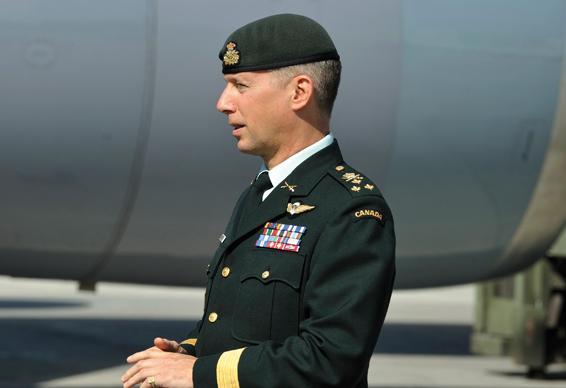
The new federal government is looking at a report on transformation prepared by Lieutenant-General Andrew Leslie before he left the military. [M.Cpl. Miranda Langguth]
The defence platform of the newly elected Liberal government was not extensive and in part vague, as other parties’ election promises were. But there were two promises the Liberals made that require a closer look.
The first of these was the promise that the Report on Transformation 2011, written by a team headed by Lieutenant-General Andrew Leslie in 2010, would be implemented. The second was a pledge to strengthen Canada’s navy in a number of specific ways with new ships and specific missions. The transformation report was prepared and written just after Leslie had stepped down from command of the army and before he retired from the Canadian Armed Forces. He is now a Liberal MP, elected on Oct. 19.
It is a very thorough document in which Leslie and his team examined military headquarters of all the services, particularly at National Defence Headquarters in Ottawa, and in great detail showed how the military side of the defence bureaucracy had ballooned in the previous 10 years, while at the same time the cutting edge of Canada’s three services had basically remained the same size. (Leslie was prohibited from examining the civilian side of the Department of National Defence.)
One of the main recommendations of this complex document was that the ranks of contractors and other experts hired by the military—almost all of them in Ottawa—had become inexplicably large and ought to be cut back drastically. A second was that the Canadian Armed Forces, and especially the army, cut the ranks of Class B reservists wherever possible and increase the ranks of Class A reservists by about 6,000, and that the savings from cutbacks essentially be shifted to the then drastically under-enrolled navy. (It still is, though not as badly.) Leslie also recommended that the major changes in the command structure introduced under Chief of Defence Staff Rick Hillier be significantly modified and simplified.
Some of Leslie’s recommendations have been implemented in the nearly five years since the report was issued. There are far fewer Class B reservists today than there were then. (Class B reservists are reservists employed on a full-time basis. Class A reservists are true part-time soldiers parading at their armouries possibly two times a week and training for several weeks during the summer). The army tends to see Class A reservists’ major role being to augment the Regular Force, but with from six months to a year of additional training before deployment. They constituted 10 to 20 per cent of the soldiers Canada sent to Afghanistan.
Canada has
too much “tail”
for too few “teeth.”
These recommendations were controversial when first released in 2011 and much of the report is still controversial today, although there is a hard kernel of truth in the observation that Canada has too much “tail” for too few “teeth.”
The problem with the Liberal government’s commitment to follow through on the full transformation report is that it has also pledged to conduct a review of Canadian defence policy. It will be the first since the Canada First Defence Strategy of 2008, which was more of a procurement strategy than a strategic policy and is now almost completely obsolete. So, Canada most certainly does need a new defence White Paper, but even if such an undertaking was a high government priority for Trudeau’s team, a decent policy review could take at least a year to produce and months more to actually implement. The same problem exists for the naval expansion.
What will no doubt happen, therefore, is that the Tory shipbuilding strategy will move forward, the complete replenishment of the remainder of the Halifax fleet will be completed and the implementation of the transformation report will be caught up in the new defence review process.
In the meantime, the Trudeau team will look about desperately for a United Nations peacekeeping mission suitable for deploying Canadian troops. It will find precious few that the CDS and service chiefs will not resist, due to inherent danger to Canadian troops, lack of effective UN command, and lack of the sophisticated support elements that only the United States can supply (as we learned in Afghanistan).
Election promises are always easy to make, much harder to keep.
Advertisement




























